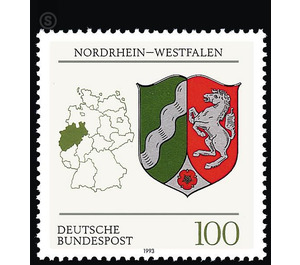Coat of arms of the Land of the Federal Republic of Germany (2) - Germany / Federal Republic of Germany 1993 - 100 Pfennig
Theme: Art & Culture
| Country | Germany / Federal Republic of Germany |
| Issue Date | 1993 |
| Face Value | 100.00 |
| Color | multi-colored white |
| Perforation | K 13 3/4 |
| Printing Type | Multicolor offset printing |
| Stamp Type | Postage stamp |
| Item Type | Stamp |
| Chronological Issue Number | 1536 |
| Chronological Chapter | GER-BRD |
| SID | 172623 |
| In 47 Wishlists | |
The state of North Rhine-Westphalia was founded by the British occupying power as part of the political-territorial reorganization of its zone in the summer of 1946. As a state reestablishment, the country could not resort to an existing national emblem and therefore had to - for the practical purposes of sealing - quickly come to an acceptable solution. At the beginning of 1947, the state government took the path of a public tender in order to give the population opportunities to participate. The aim was to obtain a state coat of arms, which corresponded to the character of the state of North Rhine-Westphalia and the requirements of the historical tradition and the coat of arms science was just. Among many proposals, the special attention was paid to unite the three coats of arms for Rhineland, Westphalia and Lippe to a new one. The draft submitted in October 1947 brought the components that were now valid, if not yet the final form: a commission set up by the State Cabinet examined this draft and ultimately made only formal changes that determine the current appearance of the North Rhine-Westphalian state coat of arms: The wave bar of the Rhenish coat of arms was placed obliquely to the left in the green field, the Westphalian horse was raised steeper, and not least the bent tip was reduced, so that the Lippe rose just found in it. This harmonized the proportions as well as the choice of the curved top line of the shield. Of these components, the Lippische Rose and the Westphalian horse are undoubtedly the most traditional. The former was from the Middle Ages sovereignty of the nobles, counts and princes and the land Lippe, and the latter took since the 16th century on the Kurkölnische coat of arms its place as a sign of the sovereignty of the archbishop of Cologne on the southern Westphalia. In contrast, the silver wave beam for the Rhenish part of the country is heraldic relatively recent date. He first appeared in 1817 in the larger Prussian coat of arms for the 1815 as "Grand Duchy of the Lower Rhine" fallen southern parts of the Rhine Province next to other coats of arms of this province, but sat down in the 1880s - even then for reasons of practical seal leadership in the provincial self-government - for the whole province. As part of the legal regulation of the state coat of arms, national colors and national flag from 1953, the form found in 1947 was binding. (Text: North Rhine-Westphalia Main State Archives)


